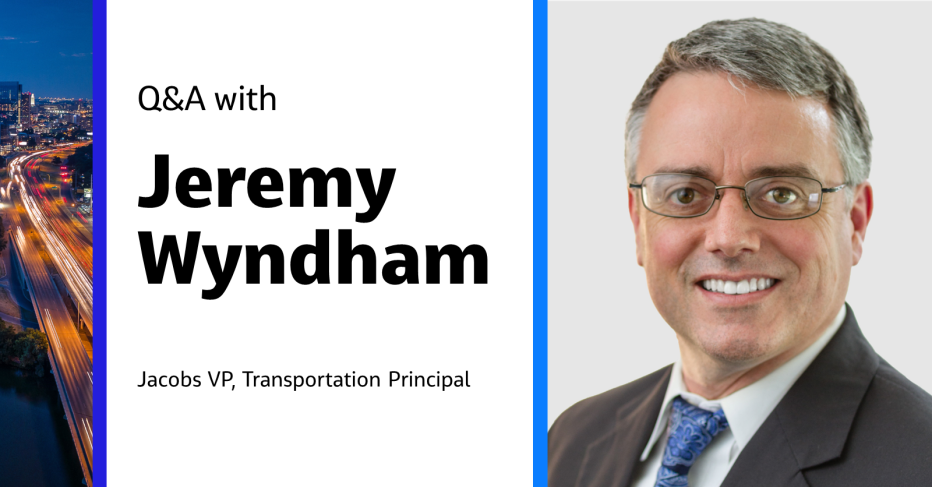
As infrastructure ages and the world population increases, resilient solutions and new technologies are key to addressing future transportation demand and keeping our world moving forward.
Whether by air, sea, underground or even through mountains, Jacobs helps our clients move people, goods and freight. Our solutions help plan, develop, finance, design, construct, maintain and operate smart transportation infrastructure that connects people and communities around the world.
But we can’t move our clients forward without our global transportation teammates and their unmatched highway engineering and design, environmental documentation, program and construction management and highway safety knowledge.
In this Q&A, we connect with one of these teammates, Jeremy Wyndham. A transportation principal and recently appointed vice president at Jacobs, Jeremy’s leading our efforts on one of the largest, most complicated projects in Texas history.
Hi, Jeremy. Tell us about your role.
I’m a vice president and transportation principal at Jacobs. Currently, I’m serving as the program manager on a large transportation program in Austin, Texas.
Prior to taking on that role two months ago, I was a transportation manager of projects, a regional transportation planning market solutions lead and our San Antonio office lead.
What are the key transportation challenges we’re solving for our clients in Texas?
Texas continues to be a high-growth state, which brings big challenges and opportunities in terms of accommodating that growth: providing for the safe transport of people and goods within and across state and international boundaries, while incorporating multi-modal solutions and future technologies into our transportation system.
Thanks to the Infrastructure Investment and Jobs Act and continued support from the legislature and citizens, Texas has considerable funding available for transportation. This puts both our client, the Texas Department of Transportation (TxDOT) and local governments under intense pressure to plan, design and construct infrastructure at unprecedented levels. Jacobs is helping our clients deliver critical infrastructure through our planning, design and Construction Engineering and Inspection (CE&I) contracts across the state.
How will data and digital technology change how we deliver transportation solutions going forward?
Data and digital solutions are already beginning to impact how we deliver transportation solutions. Four examples that immediately jumped to mind:
- Big data: We’re using StreetLight InSight®, a big data platform that’s wholly-owned by Jacobs, to inform corridor feasibility studies, traffic forecasting and alternatives analysis. We’re also beginning to use it during design, where we can – with minimal cost – verify or adjust the design coming out of the National Environmental Policy Act (NEPA) stage as we begin final design. We also use StreetLight to help our clients during the construction and operate/maintain phases of the transportation project lifecycle, pulling data related to congestion, speeds, volumes and diversions.
- Augmented and virtual reality: The industry is already using augmented and virtual reality (AR/VR) for 3D visualizations in public involvement activities. A more cutting-edge application in AR/VR uses gaming engines to place the user (i.e., stakeholder, elected official, general public) inside the virtual model of the proposed improvements, giving them the ability to look around and comment on the proposed improvements in unprecedented ways.
- Artificial intelligence (AI): We’re seeing the ability to streamline the documentation of public comments using AI, which promises to save both Jacobs and our clients considerable time and effort in documenting and responding to increasingly large volumes of public input.
- Connected and automated vehicles: As the number of connected and automated vehicles becomes a larger percentage of the overall vehicle mix, we can work with our clients to use data from these vehicles to implement more real-time solutions to traffic flows and congestion. One possibility is retiming traffic signals in real-time, for example calling a green phase early as a platoon of vehicles approaches.
Share a bit about a cool project you and your team are working on right now.
We’re working with TxDOT on its Mobility35 General Engineering Consultant (GEC) program, which is reconstructing about 80 miles of Interstate Highway 35 (I-35) through Austin, Texas and the surrounding region. One of the most congested highways in Texas, I-35 is a backbone of Texas’ connectivity and economic opportunities, and the Mobility35 program aims to upgrade this more than 50-year-old interstate to be smarter and more efficient.
As GEC, Jacobs acts as an extension of staff for the Austin District of TxDOT – planning, designing and constructing these updates that span five counties. As program manager, I lead a team of eight subconsultants and over 30 engineers, planners and environmental scientists.
Our team of specialists in public involvement, environmental analysis, schematic design, final design and construction is guiding the development of several segments of the I-35 corridor. Some are in the very early stages of planning, and some are in construction. We’re working closely with our client counterparts to implement one of the biggest and most complicated projects in Texas history.
What do you enjoy most about being part of #OurJacobs team?
Over the 28 years I’ve worked at Jacobs, I’ve worked with many talented people and challenging projects around the world. While I’ve appreciated these opportunities, I especially appreciated the diversity of thought that Jacobs fosters and drives, and I’ve seen – over and over again – the benefit of having diverse teams with diverse backgrounds to envision, plan, design and deliver the best possible solutions to our clients.
About the interviewee

As a Vice President and Transportation Principal at Jacobs, Jeremy Wyndham brings more than 30 years of experience in transportation planning and engineering for sites, corridors and regions. He’s led significant programs and projects that involved transportation planning, traffic engineering, alternatives analysis, traffic signal design, value engineering, traffic signal operations, Intelligent Transportation Systems (ITS) design, schematic design, and environmental document preparation. Having led programs and projects of varying size and complexity, he specializes in presenting complex analysis and results to diverse audiences, managing teams of professionals, and building consensus around future-focused, sustainable, resilient multi-modal solutions to transportation challenges.
Jeremy’s wife Beth is a priest in the Episcopal Church who works at St. Nicholas Episcopal Church in Bulverde, Texas. Beth and Jeremy have two adult sons.
You might be interested in...
Join #OurJacobs team
What drives you drives us as we work to build a better world – together. At Jacobs, every day is an opportunity to make the world better, more connected, more sustainable. We’re always looking for dynamic and engaged people to join our team. Bring your passion, your ingenuity and your vision.












































